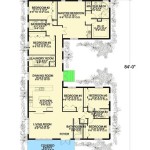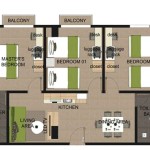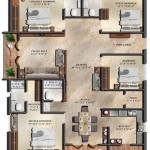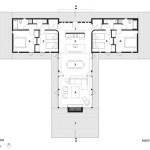How To See a Floor Plan of a House: A Comprehensive Guide
Understanding the layout of a house can be crucial for various reasons, from planning renovations and interior design to evaluating potential real estate purchases. A floor plan provides a scaled diagram of a room or building viewed from above, showing the relationships between rooms, spaces, and other physical features. Accessing and interpreting floor plans can seem daunting, but with the right tools and knowledge, it becomes a straightforward process.
This article explores the different methods to view the floor plan of a house, ranging from traditional sources to modern technological applications. We will discuss where to find existing floor plans, how to create your own if necessary, and how to accurately interpret the information presented. Whether you are a homeowner, a real estate professional, or simply curious about a property's layout, this guide provides the necessary steps to effectively see and understand a house's floor plan.
1. Locating Existing Floor Plans
The first step in viewing a house's floor plan is to determine if one already exists. Often, floor plans are readily available through various sources, saving the time and effort of creating one from scratch. Several avenues can be explored to locate pre-existing floor plans.
Real Estate Listings and Marketing Materials: One of the most common places to find floor plans is within real estate listings for houses currently for sale or that have been sold recently. Online real estate portals such as Zillow, Redfin, and Realtor.com frequently include floor plans as part of their property descriptions. These plans are often professionally drawn and provide a comprehensive overview of the home's layout, including dimensions and room labels. Printed marketing materials, such as brochures and flyers distributed by real estate agents, may also contain floor plans.
When reviewing online listings, pay close attention to the details provided. Some listings may only include a basic sketch, while others offer interactive 3D floor plans that allow virtual tours. High-quality floor plans will typically show the location of walls, doors, windows, stairs, and major appliances. They may also include dimensions of rooms and overall square footage. If a floor plan is not explicitly available on the listing, it is worth contacting the real estate agent directly to inquire if one exists or can be obtained.
Building Departments and Municipal Records: Local building departments or municipal archives often retain records of building permits and architectural plans for properties within their jurisdiction. These records can be a valuable source for obtaining floor plans, particularly for older homes or those that have undergone significant renovations. To access these records, you will typically need to contact the building department and provide the property address and any relevant information, such as the year the house was built or when renovations were carried out.
Keep in mind that accessing municipal records may require a formal request and may be subject to fees or restrictions. The availability of floor plans will also vary depending on the age of the property and the local regulations regarding record-keeping. Some jurisdictions may have digitized their records, allowing for online access, while others may require an in-person visit to review physical documents.
Architectural and Design Firms: If a house was designed or renovated by an architect or design firm, they may retain copies of the floor plans. Contacting the firm directly can be a viable option, especially if you know who designed the house or if you can find records of architectural work performed on the property. Be prepared to provide information about the house, such as its address and approximate build date, to help the firm locate the relevant plans in their archives.
Accessing floor plans from architectural firms may be subject to copyright restrictions or professional fees, particularly if the plans are being used for commercial purposes. However, if you are a homeowner seeking plans for personal use, the firm may be willing to provide a copy at a reduced cost or even free of charge.
Homeowner Associations (HOAs): In some communities, homeowner associations maintain records of architectural plans for properties within the development. This is particularly common in planned communities or those with strict architectural guidelines. Contacting the HOA can be a worthwhile step to determine if they have floor plans on file for the property you are interested in.
The availability of floor plans through an HOA will depend on the association's policies and record-keeping practices. Some HOAs may only have plans for the original construction of the homes, while others may have records of subsequent renovations or additions. It is important to inquire about the scope of the available plans and any restrictions on their use.
2. Creating Your Own Floor Plan
If existing floor plans are unavailable, the alternative is to create one yourself. This process involves measuring the house, sketching the layout, and then creating a scaled drawing. While it may seem complex, creating a floor plan can be accomplished with basic tools and techniques. Alternatively, several digital tools can simplify the process.
Manual Measurement and Sketching: The traditional method of creating a floor plan involves manually measuring the dimensions of each room and space in the house and then sketching the layout on paper. This approach requires careful attention to detail and accuracy to ensure the final floor plan is a true representation of the property. The tools needed for manual measurement and sketching include a measuring tape (preferably a long one for measuring entire rooms), a pencil, an eraser, graph paper, and a ruler or scale.
Begin by measuring the exterior walls of the house to establish the overall dimensions of the building. Then, move inside and measure the length and width of each room. Record the measurements on a rough sketch of the layout. Be sure to measure the thickness of walls, the size and location of doors and windows, and the position of any built-in features such as fireplaces or cabinets. It is also beneficial to note the location of electrical outlets, light switches, and plumbing fixtures.
Once all the measurements have been collected, transfer the information to the graph paper to create a scaled drawing. Choose a scale that allows the entire floor plan to fit on the paper, such as 1/4 inch equals 1 foot. Use the ruler or scale to accurately draw the walls, doors, windows, and other features according to the measurements. Label each room and indicate the dimensions to provide a clear and informative floor plan.
Digital Floor Plan Software: Several software applications are designed specifically for creating floor plans. These tools offer a user-friendly interface and a range of features that simplify the process. Popular options include AutoCAD Architecture, SketchUp, RoomSketcher, and Planner 5D. These programs often provide libraries of pre-designed furniture, appliances, and architectural elements that can be easily added to the floor plan. They also allow for the creation of 3D models and virtual tours.
The advantage of using digital floor plan software is the ability to create accurate, professional-looking plans with ease. These programs offer precise measurement tools, automatic scaling, and the ability to easily edit and revise the floor plan as needed. Many also allow for collaboration, enabling multiple users to work on the same plan simultaneously. While some software options require a subscription fee, many free or low-cost alternatives are available for basic floor plan creation.
Mobile Apps and Laser Measurements: A variety of mobile apps have emerged that leverage the capabilities of smartphones and tablets to simplify the process of creating floor plans. These apps often use the device's camera and augmented reality (AR) technology to measure distances and create a 3D model of the space. Some apps also integrate with laser measuring tools, which provide highly accurate measurements for creating precise floor plans.
Laser measuring tools, such as laser distance meters, can significantly speed up and improve the accuracy of the measuring process. These devices use a laser beam to measure distances quickly and easily, even in hard-to-reach areas. By connecting a laser measuring tool to a mobile app, you can automatically transfer measurements to the app and create a floor plan in real-time. Popular apps that support laser measurements include Magicplan and RoomScan Pro.
Professional Assistance: If creating a floor plan yourself seems too daunting or time-consuming, consider hiring a professional to do it for you. Architects, interior designers, and drafting services can create accurate and detailed floor plans based on measurements and sketches. While this option involves a financial investment, it can be worthwhile, especially for complex projects or when a high degree of accuracy is required.
When hiring a professional, be sure to provide them with as much information as possible about the house, including any existing plans, photographs, and specifications. Discuss your specific needs and requirements for the floor plan, such as the level of detail required and the intended use of the plan. Obtain a written estimate before commencing the work and ensure that the contract clearly outlines the scope of services and the deliverables.
3. Interpreting Floor Plans
Once you have obtained a floor plan, understanding its features and symbols is crucial. Floor plans use a standardized set of symbols and conventions to represent various elements of a house, such as walls, doors, windows, and appliances. Learning to interpret these symbols will allow you to accurately visualize the layout and features of the property.
Understanding Common Symbols: Floor plans use specific symbols to represent structural and functional elements of a building. A solid, thick line typically represents walls. Doors are shown as an arc indicating the direction of the swing, while windows are depicted as parallel lines within the wall. Stairs are shown as a series of parallel lines indicating the steps, along with an arrow showing the direction of ascent. Plumbing fixtures, such as toilets, sinks, and bathtubs, are represented by stylized drawings of the fixtures. Appliances, such as refrigerators, stoves, and washing machines, are also represented by simplified drawings.
In addition to these basic symbols, floor plans may include symbols for electrical outlets, light switches, smoke detectors, and HVAC systems. It is important to familiarize yourself with these symbols to accurately understand the location of these features in the house. Many floor plans include a legend or key that explains the meaning of each symbol used in the plan.
Analyzing Dimensions and Scale: Floor plans are drawn to scale, meaning that the dimensions of the rooms and features are proportional to their actual size. The scale of the floor plan is typically indicated on the plan itself, such as 1/4 inch equals 1 foot or 1:50. Understanding the scale allows you to accurately measure the dimensions of rooms and features on the plan and convert them to real-world measurements. To measure the dimensions of a room, use a ruler or scale to measure the length and width on the plan and then multiply those measurements by the scale factor. For example, if the scale is 1/4 inch equals 1 foot and the length of a room measures 3 inches on the plan, the actual length of the room is 12 feet (3 inches x 4 feet per inch).
When analyzing dimensions and scale, it is important to pay attention to the units of measurement used on the plan. Floor plans in the United States typically use feet and inches, while those in other countries may use meters and centimeters. Be sure to convert the measurements to a consistent set of units to avoid confusion.
Recognizing Structural Elements: Floor plans provide insights into the structural components of a house, indicating the location of load-bearing walls, columns, and beams. Load-bearing walls are typically indicated by thicker lines on the plan and are critical for supporting the weight of the building. Understanding the location of load-bearing walls is essential for planning renovations or alterations to the structure.
Floor plans also show the location of columns and beams, which are used to provide support for floors and roofs. These elements are typically represented by solid rectangles or circles on the plan. Understanding the location of these structural elements is important for ensuring the safety and stability of the house during renovations or alterations.
Considering Spatial Relationships: Floor plans illustrate the relationships between different rooms and spaces in the house. By analyzing the floor plan, you can understand how rooms are connected and how people will move through the house. Consider the flow of traffic and the proximity of different rooms to each other. For example, is the kitchen conveniently located near the dining room? Are the bedrooms separate from the living areas to provide privacy?
Floor plans also reveal the size and shape of each room and how they relate to the overall layout of the house. Understanding the spatial relationships within the house can help you plan furniture arrangements, allocate space for different activities, and optimize the use of the available space.

How To Read A Floor Plan With Dimensions Houseplans Blog Com

9 Ways To Find Floor Plans Of An Existing House Blueprints Archid

How To Properly Read Floor Plans And What Details Look For

House Plans How To Design Your Home Plan

How To Read A Floor Plan With Dimensions Houseplans Blog Com

Floor Plans Types Symbols Examples

9 Ways To Find Floor Plans Of An Existing House Blueprints Archid

How To Read A Basic Floor Plan Lofty Building Group

Home Plan Buyers Learn How To Read A Floor Blueprint Blog Eplans Com

How To Read A Floor Plan With Dimensions Houseplans Blog Com
Related Posts








